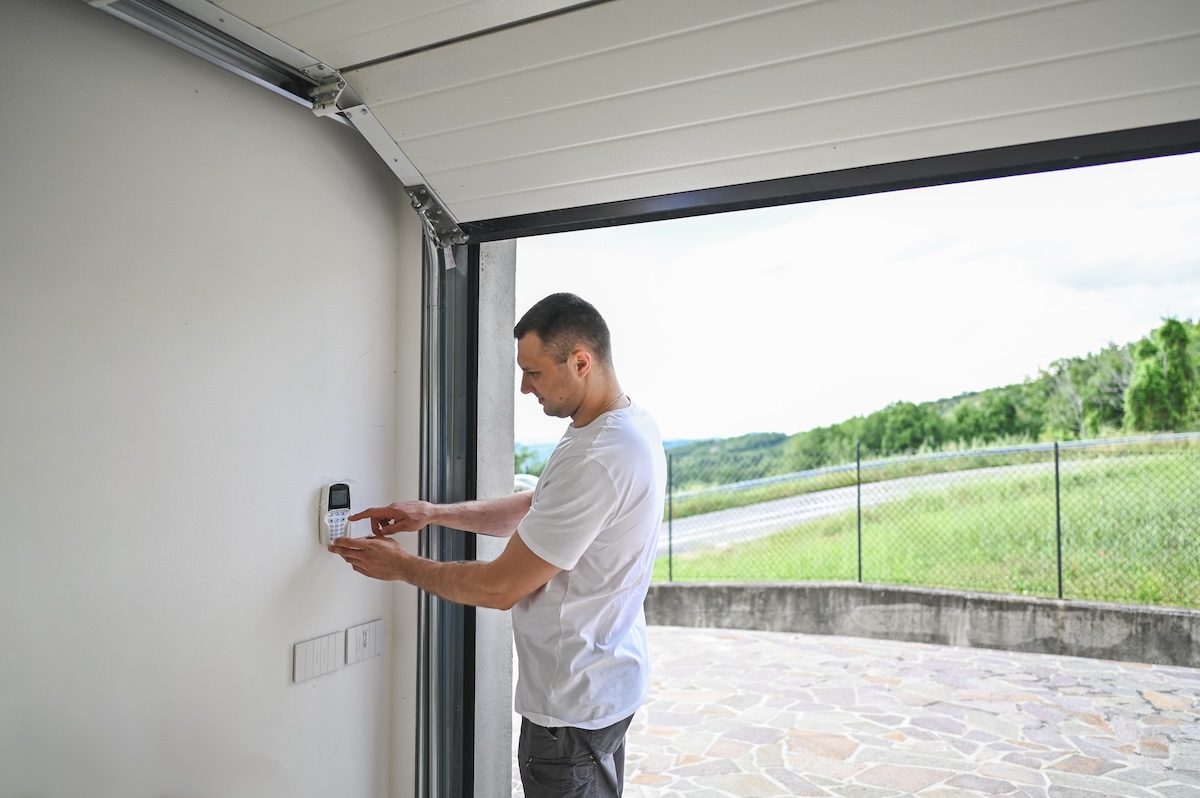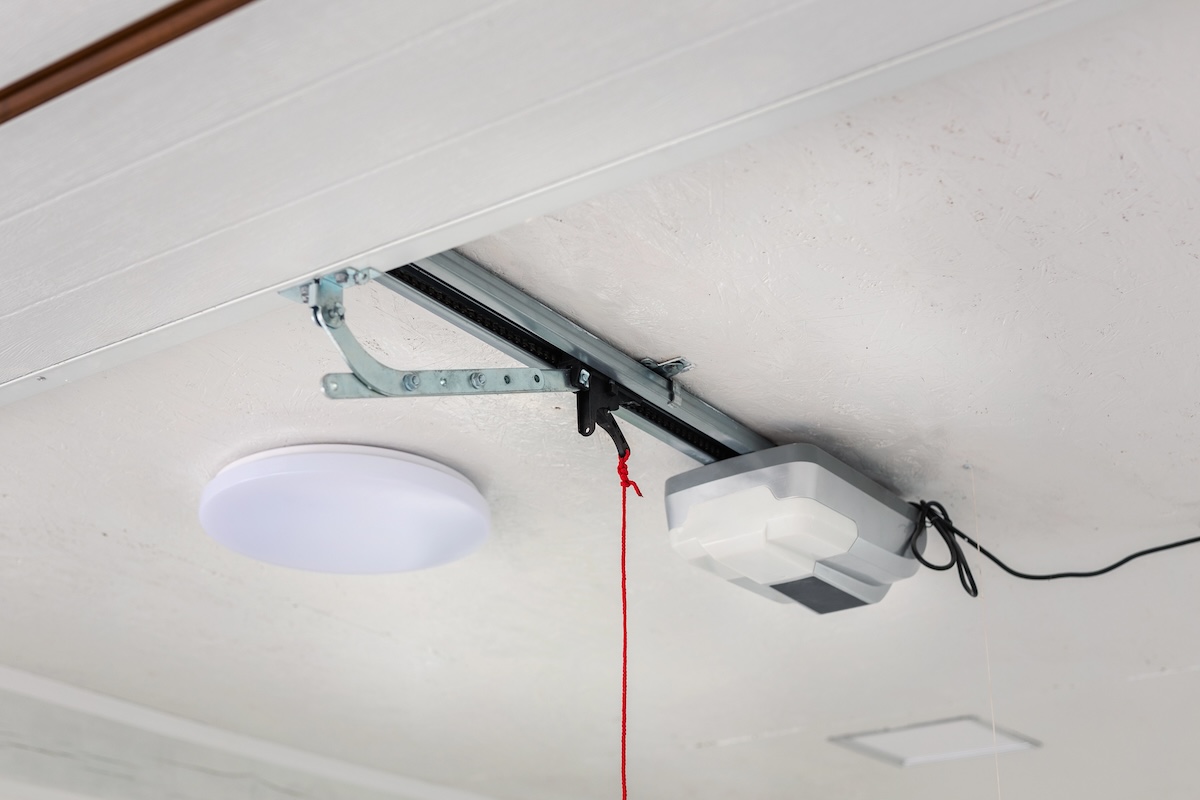

We may earn revenue from the products available on this page and participate in affiliate programs. Learn More ›
Your house is only as safe as its weakest entry point, and for many, that point is an overhead garage door. While homeowners typically install strong front entry doors, garage door security often takes a back seat, which is unfortunate, as approximately 9 percent of burglars break in through the garage, according to the National Association of Certified Home Inspectors. These simple solutions can help protect your garage door, dissuade thieves, and gain priceless peace of mind.
1. Obscure the garage interior by frosting the windows.
Windows liven up the look of a garage door and let in natural light. Unfortunately, potential thieves are apt to peer in through the windows, scoping for expensive tools and to see if all the cars are gone—a good sign that nobody’s home, which may prompt a break-in. Adding a layer of frosted film, such as the highly rated Coavas Window Privacy Film, to the windows will keep crooks from seeing what’s inside while still allowing light to filter through.
2. Monitor activity with a smart garage door opener or other device.

Standard garage door openers do add a layer of security—they lock the door when it’s shut. But a determined burglar can still try to force their way in or hack a weak code. That’s where smart tech can help.
Smart garage door openers, like the Chamberlain MyQ Smart Garage Control, let you monitor your garage door from your smartphone. You can check if it’s open or closed, get real-time alerts, and even open or close it remotely—all through an app. Many systems now allow you to use your phone as the garage door remote itself, so there’s no need to carry a separate clicker.
Don’t have a compatible opener? No problem. Devices like the GarageDoorBuddy Monitor attach to your garage door frame and connect to your Wi-Fi. They send an instant notification to your phone anytime the door is opened or closed—even if it was opened manually.
3. Don’t leave your garage door opener in your car.
It might be convenient to clip that remote to your sun visor, but it’s also one of the first places a thief will check if they break into your car. That remote is basically a key to your home—so treat it like one. Keep it in your pocket, purse, or bring it inside and stash it with your keys.
If you use a key fob or built-in vehicle remote, you’re not totally off the hook, either. Some older garage systems use fixed codes, which can be spoofed or cloned with relatively inexpensive tech. To stay ahead of hackers, upgrade to a rolling code garage door opener, which changes the code every time the door is used. Most modern openers, including those from Chamberlain and LiftMaster, use this more secure tech by default.
For added peace of mind, many smart systems let you disable remote access when you’re away or set schedules that automatically close the door after a certain time.
4. Light up the area to keep intruders away.

Darkness is a burglar’s best friend. Installing motion-activated floodlights outside your garage can stop trouble before it starts—most intruders will think twice if they’re suddenly caught in a bright spotlight.
For easy installation, solar-powered models are a great choice since they don’t require wiring. Look for lights with wide-angle sensors and a solid range. The Ring Smart Floodlight, for example, can detect motion up to 70 feet away and shine a bright beam that covers a broad area.
Bonus: These lights also make it easier (and safer) for you to navigate your driveway at night.
5. Add a manual garage lock for extra protection.
If your garage door has a handle and opens manually, install a locking handle to keep intruders out. A product like the Prime-Line GD Keyed T-Handle Lock adds a layer of security by requiring a physical key to open the door.
You can also reinforce your setup from the inside. The Accessories 22 Garage Door Slide Lock Lock attaches to the door and frame, and you simply slide the bar into place before heading into your home. Once locked, it prevents anyone from opening the door until you release it.
These low-tech solutions might seem basic, but they’re incredibly effective at stopping unauthorized entry.
6. Lock the door between your garage and your house.
Many homes have attached garages that make it handy to get in and out of the house without having to walk through inclement weather, but that connecting door is a major security risk if you fail to lock it. Once a burglar gains access to your garage, he can walk right into your home. Always keep the connecting door locked, and for greater garage door security, install a steel security door with a deadbolt in this spot.
7. Reduce garage break-in risk with security cameras.
Security cameras are a huge deterrent to would-be burglars who know the cameras are recording their facial features, clothing, and other physical attributes. A motion-activated camera starts recording as soon as a car pulls into the driveway or someone approaches on foot—even at night.
For example, the Google Nest Cam will record any activity it finds in its field of view (which you can configure to avoid it sending you notifications every time a dog walker walks by—unless you want that). These videos are stored in the cloud and can be viewed from your smartphone app. Plus, the camera syncs with smart home systems such as Alexa as well as smartphones, so you can check on the status of your garage door even when you’re off-site.
Google’s suite of security products are also the chosen brand for ADT, so you know they must be impressive.
8. Stop a common break-in trick with one quick snip.

Speaking of ADT, after an installer walked me through the smart security camera setup, he shared one of the simplest (and scariest) tricks burglars use to break into garages: a wire hanger.
Here’s how it works: A thief slips a wire hanger through the space between the garage door and the frame, and uses it to hook the emergency release cord—the one with the red loop that lets you manually open the door from inside. Once they tug that, the whole door can be lifted, no key or opener needed.
What can you do to keep this from happening? Just cut the loop in that emergency cord. By snipping it so there’s no longer a hookable loop, you eliminate the easiest way for a hanger to catch onto it. You’ll still be able to pull it in an emergency, but a burglar with a wire will be out of luck.
It’s a quick DIY tweak that takes less than a minute, and could seriously improve your garage security.
